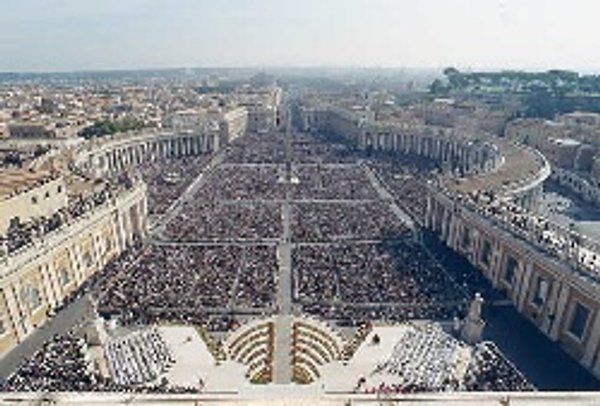Pope John Paul II canonized Josemaría Escrivá, the founder of Opus Dei, on October 6 before a crowd overflowing St. Peter´s Square. A Mass of thanksgiving the next day was celebrated in St. Peter’s Square by Bishop Javier Echevarria, the Prelate of Opus Dei, and was followed by an audience with the Pope and an appearance by Romanian Orthodox Patriarch Teoctist.
In his homily at the canonization Mass on October 6, the Pope said that the new saint was calling on Christians to “raise the world towards God and to transform it from within,” and not to be swayed “by a materialistic culture, which threatens to dissolve the most genuine identity of the disciples of Christ.”

Among the pilgrims at Escrivá’s canonization was the doctor whose inexplicable cure opened the doors for the Opus Dei founder to be declared a saint. Dr. Manuel Nevado Rey had chronic and incurable radiodermatitis, which disappeared after he sought Blessed Escrivá's intercession in 1992. At the canonization, the doctor said: "I am unimaginably happy. Four children and three grandchildren have come with me and my wife. I am overwhelmed when I think that at 70 years I am here, alive and kicking."
The Italian government estimated 300,000 in attendance at the canonization. Among these were forty-two cardinals and 470 bishops from around the world, general superiors of many orders and religious congregations, and representatives of various Catholic groups, including Carl Anderson, the Supreme Knight of the Knights of Columbus, Kiko Argüello and Carmen Hernández, founders of the Neocatechumenal Way, Father Marcial Maciel, founder of the Legionaries of Christ and the Regnum Christi movement, and Andres Riccardi, founder of the Community of Sant'Egidio.
James Nicholson, the United States Ambassador to the Holy See, was in attendance. “I found it very moving and inspiring to see a humble priest proclaimed a saint in the presence of hundreds of thousands of people,” said Mr. Nicholson. He added, “I think the message is clear: when people are living their lives in a manner where they are fulfilling their responsibilities, being good husbands, sons or daughters, they are doing something very important in God’s eyes. You don’t have to be a rock star or an athlete to live your life right.”

Lech Walesa, the Solidarity union leader who helped bring about Poland’s transition to democracy, was also in attendance. “At last we have a saint for the workers,” he said.
St. Peter's Square was overflowing again on October 7 for a Mass of Thanksgiving, presided over by Bishop Javier Echevarría, prelate of Opus Dei. “When you return home,” said Echevarría in his homily, “bring back with you the teachings of the new Saint and try to put them into practice. Ask Saint Josemaria to teach you to convert the prose of each day — your most ordinary occupations — into poetry, into heroic verse: into desires and deeds of holiness and apostolate.”
Following the celebration of Mass, John Paul II arrived in the square for an audience. He drove up and down the aisles, stopping occasionally to wave and kiss babies passed to him. The Pope then addressed the crowd, describing Escriva as “the saint of the ordinary.” As he spoke about the new saint, John Paul II looked out at all the people from scores of countries and said that they were "a sign of the apostolic zeal that burned in the soul of St. Josemaría."
At the end of the audience with the Pope, the Romanian Orthodox Patriarch Teoctist arrived in the Square and greeted the crowd. He is visiting Rome in gratitude for the Holy Father’s visit to Romania in May 1999, the first papal visit to Orthodox lands. This was the first official event of the patriarch's visit to Rome.


